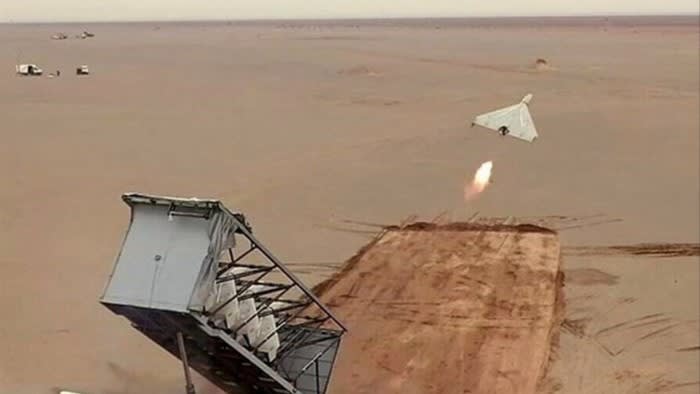A barrage of more than 300 armed drones and long-range missiles that Iran fired at Israel late Saturday was met with an unparalleled defensive response.
According to the Israeli army, 99% of the missiles were intercepted, with only a small number of ballistic missiles landing in Israeli territory. These explosions caused minor damage to an air base in the south of the country, although a child was seriously injured, likely due to falling shrapnel.
“The Iranian attack was thwarted, as it was planned,” Daniel Hagari, an Israeli army spokesman, said in the early hours of Sunday morning.
Iran launched its attack in response to a suspected Israeli raid in Damascus earlier this month that killed a number of Iranian leaders, marking the first time it has directly targeted the Jewish state.
Israel's ability to intercept the attack and prevent any loss of life is a testament to its “layered” missile defense system that includes Israel's much-vaunted air defense array. The array's arrow element, which is intended to physically intercept long-range projectiles, was successfully deployed during the Iranian attack, according to Israeli military officials.
Israel has also received assistance from international partners, including the United States, the United Kingdom and France, as well as allies in the Middle East whose names have not yet been revealed. Two American planes and two destroyers participated in intercepting the bombing, and planes from the Royal Air Force also launched.
British Prime Minister Rishi Sunak confirmed on Sunday that RAF pilots shot down a number of Iranian attack drones and helped save lives “not only in Israel, but in neighboring countries like Jordan as well.” He said that if the attack was successful, “it would be difficult to overestimate its repercussions on regional stability.”
In Kiev, President Volodymyr Zelensky highlighted the devastating impact of Iranian drones, such as the Shahed, that Russia is using in its war in Ukraine.
“The sound of Shahid drones, a tool of terrorism, is the same in the skies of the Middle East and Europe. This sound should serve as a wake-up call to the free world,” he said.
Hagari described the response to the Iranian attack as “one of the most unique air defense battles” in the history of military warfare, referring to the huge number of fighter jets and interceptor missiles deployed to stop the attack that began over the course of several hours.

The defensive effort began with early radar warning from forward bases near Iran operated by the US military's Central Command. These missiles detected the initial swarm of departing drones, and later ballistic and cruise missiles launched from Iran, Iraq and Yemen.
Israel officially joined the US-led regional military command in 2021, following the Abraham Treaties signed with several Arab countries. Since then, the Israeli military has participated in annual war games, with an emphasis on air defence, as part of a thriving network dubbed the Middle East Air Defense Alliance.
After receiving the warnings, Western fighter jets and air defenses deployed to intercept the wave of Iranian missiles and drones heading towards Israel over several countries in the Middle East. Israeli F-35 stealth fighters already in the air stray beyond the borders of the Jewish state to intercept the bulk of the incoming missiles.
None of the 170 armed drones launched by Iran penetrated Israeli airspace, according to Israeli military data. The Israeli army also said that Israeli aircraft shot down 25 of the 30 missiles heading towards it outside the country's borders.
Those missiles and drones that made it past the initial interception phase had to contend with deliberate and widespread jamming of the GPS signal, not only over Israel but also over neighboring countries.
In addition to the Arrow system, Israel's air defense array also includes the Iron Dome and David's Sling systems aimed at intercepting short- and medium-range projectiles, respectively. But it was almost certainly the Arrow missile that dealt with most of the 120 ballistic missiles launched by Tehran.
Arrow interceptors are intended to match the trajectory of high-altitude ballistic missiles and then intercept them, hitting them near spaceflight. This may be the reason behind the widespread alerts that went off throughout southern, northern and central Israel, including Jerusalem, as well as the night sky lighting up with countless lights from Arrow interceptors.
Among the “small number” of heavy shells that penetrated Israeli airspace, some struck the Nevatim air base in the southern Negev desert, which remained fully operational.
But for Israeli officials, it was evidence, as one put it, that “a strong defense alliance has shown that it can stand up to Iran and create deterrence against it.”
Hagari pointed out that such a large number of ballistic missiles that were launched in a short time was unprecedented in the annals of war, as Israel considered it an “escalation factor” in the long history of the conflict between the two countries.
Recommended
Israeli officials, including Prime Minister Benjamin Netanyahu, have vowed to respond directly to Iran if it attacks. Most Israeli analysts now consider such a response to be only a matter of time.
Yaakov Lapin, an Israel-based defense analyst, said the attack was “a resounding strategic failure for Iran” and “a collapse of a fundamental principle of its principles.” [its] Force projection – its arsenals of conventional missiles and drones.”
“Iran must now wait for Israeli retaliation, but unlike Israel, Iran’s air defenses are limited by comparison. . . . A response on Iranian soil seems certain.”
Additional reporting by Anna Gross in London and Christopher Miller in Kiev

